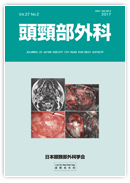Volume 27, Issue 2
Displaying 1-20 of 20 articles from this issue
- |<
- <
- 1
- >
- >|
-
2017Volume 27Issue 2 Pages 141-144
Published: October 30, 2017
Released on J-STAGE: November 22, 2017
Download PDF (272K)
-
2017Volume 27Issue 2 Pages 145-150
Published: October 30, 2017
Released on J-STAGE: November 22, 2017
Download PDF (1545K) -
2017Volume 27Issue 2 Pages 151-153
Published: October 30, 2017
Released on J-STAGE: November 22, 2017
Download PDF (582K) -
2017Volume 27Issue 2 Pages 155-160
Published: October 30, 2017
Released on J-STAGE: November 22, 2017
Download PDF (1318K) -
2017Volume 27Issue 2 Pages 161-163
Published: October 30, 2017
Released on J-STAGE: November 22, 2017
Download PDF (524K)
-
2017Volume 27Issue 2 Pages 165-167
Published: October 30, 2017
Released on J-STAGE: November 22, 2017
Download PDF (927K)
-
2017Volume 27Issue 2 Pages 169-172
Published: October 30, 2017
Released on J-STAGE: November 22, 2017
Download PDF (664K)
-
2017Volume 27Issue 2 Pages 173-178
Published: October 30, 2017
Released on J-STAGE: November 22, 2017
Download PDF (570K) -
2017Volume 27Issue 2 Pages 179-185
Published: October 30, 2017
Released on J-STAGE: November 22, 2017
Download PDF (1327K) -
2017Volume 27Issue 2 Pages 187-191
Published: October 30, 2017
Released on J-STAGE: November 22, 2017
Download PDF (1081K) -
2017Volume 27Issue 2 Pages 193-198
Published: October 30, 2017
Released on J-STAGE: November 22, 2017
Download PDF (1248K) -
2017Volume 27Issue 2 Pages 199-203
Published: October 30, 2017
Released on J-STAGE: November 22, 2017
Download PDF (1858K) -
2017Volume 27Issue 2 Pages 205-210
Published: October 30, 2017
Released on J-STAGE: June 01, 2015
Download PDF (2113K) -
2017Volume 27Issue 2 Pages 211-215
Published: October 30, 2017
Released on J-STAGE: November 22, 2017
Download PDF (1417K) -
2017Volume 27Issue 2 Pages 217-221
Published: October 30, 2017
Released on J-STAGE: November 22, 2017
Download PDF (3854K) -
2017Volume 27Issue 2 Pages 223-229
Published: October 30, 2017
Released on J-STAGE: November 22, 2017
Download PDF (519K) -
2017Volume 27Issue 2 Pages 231-234
Published: October 30, 2017
Released on J-STAGE: November 22, 2017
Download PDF (439K) -
2017Volume 27Issue 2 Pages 235-239
Published: October 30, 2017
Released on J-STAGE: November 22, 2017
Download PDF (299K)
-
A case of the parathyroid cancer causing retropharyngeal hematoma with near-total airway obstruction2017Volume 27Issue 2 Pages 241-246
Published: October 30, 2017
Released on J-STAGE: November 22, 2017
Download PDF (1471K) -
2017Volume 27Issue 2 Pages 247-252
Published: October 30, 2017
Released on J-STAGE: November 22, 2017
Download PDF (1672K)
- |<
- <
- 1
- >
- >|
